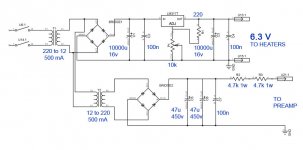hi all .
i m trying to build a very very small and simple tube pre amp for my bass guitar ,using a 6av6, the only problem is i m tryin to put it in a very small case ( almost in the size of standard floor pedals ) and so i have to get rid of supply transformer ,
here s the circuit i m going to build ,using the main standard city supply ! so what do u think ? any problem ??? any idea ?
(attachment removed by moderators for safety reasons)
i m trying to build a very very small and simple tube pre amp for my bass guitar ,using a 6av6, the only problem is i m tryin to put it in a very small case ( almost in the size of standard floor pedals ) and so i have to get rid of supply transformer ,
here s the circuit i m going to build ,using the main standard city supply ! so what do u think ? any problem ??? any idea ?
(attachment removed by moderators for safety reasons)
That circuit won't work. C1 will explode soon due to wrong voltage rating, also the LM317 will die in seconds.
And of course, you can die yourself too.
Check out the many many designs with only 12V as power supply, for example:
http://www.dogstar.dantimax.dk/tubestuf/mctube.htm
And of course, you can die yourself too.
Check out the many many designs with only 12V as power supply, for example:
http://www.dogstar.dantimax.dk/tubestuf/mctube.htm
This idea is LETHAL! Just follow the circuit. There is a path from one side of your power source to circuit ground. There is a path from circuit ground to your left hand. It is the guitar cord, the guitar and the guitar strings. Now if you touch anything grounded with your other hand, feet, or mouth (microphone), you WILL BE FRIED! Yes, I know that the European power source is supposed to be floating, but that in only true in the ideal sense, and if there are NO other loads plugged in that have any leakage paths in them. Do you trust your life to this?
Nowhere is this more important than in a guitar amp. Think about how sweaty most performers get during a live performance, and realize that you are ALWAYS connected to the ground circuit of your equipment. Make sure it IS ground!
Nowhere is this more important than in a guitar amp. Think about how sweaty most performers get during a live performance, and realize that you are ALWAYS connected to the ground circuit of your equipment. Make sure it IS ground!
Ahmad_tbp said:)))))) ... very very first design ever ! , very very failure ever !!!
thank u so much men, so i need a transformer for sure ! , better go for McTube supply , yeah ?
Hey, its cool, I'm sure we've all either deisgned something lethal, or cheated death in some way, when i first started with tubes, I touched an All American 5 radio when it was plugged in
 so keep on tubeing!
so keep on tubeing!Much safer.
Some notes: the first transformer should be very overrated, or it could suffer from heavy sag under load, use a 2A unit.
And those 4k7 resistors at the output of the high voltage PSU should go in between filter caps, not at the output, to implement some sort of pi filter.
Also, put the LM317 on a suitable heatsink. It will get hot with 3W dissipation.
Some notes: the first transformer should be very overrated, or it could suffer from heavy sag under load, use a 2A unit.
And those 4k7 resistors at the output of the high voltage PSU should go in between filter caps, not at the output, to implement some sort of pi filter.
Also, put the LM317 on a suitable heatsink. It will get hot with 3W dissipation.
(attachment removed by moderators for safety reasons)
Am I to assume that there was at one point a somewhat crude power supply attached to the thread?
Maybe in your infinite wisdom you have possibly overlooked the chance to school those less educated in power supply design.
By totally removing the attachment absolutely nothing can be learned by someone elses engineering mistake. By leaving the attachment on the thread attention could be drawn to each mistake therefore eliminating the possibility of someone trying it again.
Good going boys
burnedfingers said:
Am I to assume that there was at one point a somewhat crude power supply attached to the thread?
Maybe in your infinite wisdom you have possibly overlooked the chance to school those less educated in power supply design.
By totally removing the attachment absolutely nothing can be learned by someone elses engineering mistake. By leaving the attachment on the thread attention could be drawn to each mistake therefore eliminating the possibility of someone trying it again.
Good going boys
While I do understand the case you are making, and agree with it to some level, I believe that most people on the forum (including the god-like moderators, with their executive power) side with caution.
It is unfortunate that removing it doesn't make it go away. Expanding on the point has the capability to school or teach why it is important to use a transformer. I guess the easier and quicker path is better. Right?
Enough said...no transformer, no schematic, no discussion.
Enough said...no transformer, no schematic, no discussion.
There is an alternative....
Not really a Great answer to your problem, I didnt see the schme, as its been removed, but can guess the layout...
How about a small battery powered inverter for the +B the battery also supplying the heaters...? As its only a pre-amp, the current requirements would be quite low if the choice of tube was sensible Rechargeable batts could be used, and charged when the unit was not in use......
This could be made pretty safe and fairly foolproof...
Not really a Great answer to your problem, I didnt see the schme, as its been removed, but can guess the layout...
How about a small battery powered inverter for the +B the battery also supplying the heaters...? As its only a pre-amp, the current requirements would be quite low if the choice of tube was sensible Rechargeable batts could be used, and charged when the unit was not in use......
This could be made pretty safe and fairly foolproof...
burnedfingers said:It is unfortunate that removing it doesn't make it go away. Expanding on the point has the capability to school or teach why it is important to use a transformer. I guess the easier and quicker path is better. Right?
Enough said...no transformer, no schematic, no discussion.
I see your point, and it is a good one. Many who come to this forum don't know much about electronics or electricity but are eager to build things. It is an easy way out to just tell them to always use a transformer. First, they may still make a dangerous circuit with a transformer if they don't understand why it is dangerous without one. If they don't know why they should use one, how should they now how to use it? Second, while some are just happy to get told how to do things, many actually do want to learn, and they may want to understand why a circuit without a transformer is very dangerous, and also how one should not use a transformer.
At the same time I understand the reasons for not allowing arbitrary schematics of that type to be posted. There is one possible solultion I see, but that requires that somebody does a bit of work, and I won't volunteer. One could do something permanent, perhaps in the Wiki, explaining why it is dangerous not to use a transformer and how to properly use one. Then one might have a few archetypical schematics of dangerous circuits for pedagogical reasons, and these schematics could then have big red warning texts stamped over the circuit, or whatever the mods find necessary to scare people off from building them. Perhaps there already is such a web page somewhere on the net that one could just link to whenever somebody attempts something lethal?
Transformerless amps were designed to be cheap garbage. I see no point in passing on that knowlege. Amps we build are dangerous enough as it is. Kudos to the moderators.
Once a month, somebody brings me some ebay crap (guitar amp to them) without a transformer, and I have to explain the same thing. It is dangerous junk, and I am not working on it. If I had more balls, I would clip the power cord before returning it to the sucker, er..., clueless owner.
If somebody really wants a schematic of a transformerless amp, it is basically this:
Once a month, somebody brings me some ebay crap (guitar amp to them) without a transformer, and I have to explain the same thing. It is dangerous junk, and I am not working on it. If I had more balls, I would clip the power cord before returning it to the sucker, er..., clueless owner.
If somebody really wants a schematic of a transformerless amp, it is basically this:
Attachments
ethermion said:Transformerless amps were designed to be cheap garbage. I see no point in passing on that knowlege. Amps we build are dangerous enough as it is. Kudos to the moderators.
You are misunderstanding us. The point is not to show how to do a transformerless amp, but to illustrate and explain why one must not do it. But I realize I was unclear. It shouldn't be complete schematics of amps, and it shouldn't be just schematics, but simplified schematics with annotations, arrows and whatever pedagagogical means is useful to explain what happens and why it is dangerous. There are books about safety issues. They must necessarily show examples of what is wrong and why it is wrong to illustrate the text.
I think if you show a schematic with a big red cross over the whole schematic and a big red warning text saying "This will kill you. Do not build it." then people will get it. If they don't, they will probably get themselves killed by something else before they get a chance to build it.
In case I wasn't clear, I will repeat myself. This is a transformerless amp:
I don't agree. Yes it is transformerless. No, it is not an amp.
I definitely agree with what you probably meant, but didn't say: Don't try this at home!
No, you are misunderstanding the very clear picture. I thought a picture was worth a thousand words, but perhaps not....
Not a schematic per se, but a clear graphical representation of a transformerless amp. I would expect high distortion, oscillations, moisture, and perhaps a bad smell. No need to develop this further.
Not a schematic per se, but a clear graphical representation of a transformerless amp. I would expect high distortion, oscillations, moisture, and perhaps a bad smell. No need to develop this further.
ethermion said:No, you are misunderstanding the very clear picture. I thought a picture was worth a thousand words, but perhaps not....
Not a schematic per se, but a clear graphical representation of a transformerless amp. I would expect high distortion, oscillations, moisture, and perhaps a bad smell. No need to develop this further.
Ah, Ok. I am usually the one being to abstract for others to follow me. In this case I was to stuck on the concrete level to understand you.
Actually, maybe you are on spot here. Whenever somebody attempts something transformeless, we might just post that picture and say, this is what you are trying to do. Do you really want that?
Still, there will be people who say: Yes, I trust you I shouldn't do it, but I still want to understand why it is dangerous. Tricky, tricky.
- Status
- Not open for further replies.
- Home
- Amplifiers
- Tubes / Valves
- transformerless supply


